 |
PO
Box 9021, Wilmington, DE 19809, USA
E-mail: font@focusonnature.com
Phone: Toll-free in USA 1-888-721-3555
or 302/529-1876 |
 Japan
Birds
Japan
Birds
from Minivets to Buntings
noting those found
during
Focus On Nature Tours
with an (*)
1994 thru 2015
during the months of
January, February, April.
May, June, July, October,
November, and December
Part 2 of a List of Japan
Birds with some photos
compiled by Armas Hill, the leader of FONT tours in Japan
Photo at upper right: a BROWN-EARED BULBUL photographed during a FONT Japan
Tour
Link:
Part
#1 of this List of Japan Birds: Pheasants to Pittas
There have been 24 FONT Fall
& Winter birding & nature tours in Japan: FW.
There have been 13 FONT Spring & Summer birding & nature tours in Japan: SS.
During our 37 FONT tours in Japan, 397 species of birds have cumulatively been found.
In the following list, Japanese bird
names follow English names.
Codes:
(JAi): introduced species in Japan
(t): a globally threatened or
rare species, designated by Birdlife International.
(t1): critical
(t2): endangered
(t3): vulnerable
(nt): considered a
near-threatened species globally
(JAr): rare in Japan
(JArs): rare in Japan in spring/summer
(JArw): rare in Japan in
winter
(JAe): Japanese endemic
(JAeb): Japanese endemic breeder
(JAneb): Japanese near-endemic breeder
FW: Seen during FONT Fall
& Winter Japanese birding tours.
SS: Seen during FONT Spring & Summer Japanese birding tours.
In the list that follows,
relating to sightings during FONT tours, the Japanese island & the months
are noted.
HN: on Honshu
HI: on Hegura Island (Hegura-jima) in the Sea of Japan off
Honshu (Hegura Island
visited during our Spring tours)
HK: on Hokkaido
KY: on Kyushu
AM: on Amami
OK: on Okinawa
NS: in the
southern Japanese islands of Nansei Shoto (other than Amami
& Okinawa)
(ph): species with a photo in this FONT website
Links to Bird Groupings in this List:
Shrikes
Orioles & Drongos Corvids
Tits (& Penduline Tit) Waxwings
Swallows & Martins
Long-tailed
Tit Larks Bulbuls
Old
World Warblers
Laughing Thrushes, Leiothrix, White-eyes
Wren Nuthatches
Starlings
Thrushes
Old World Flycatchers & Monarch
Dipper Sparrows & Munias
Accentors
Pipits & Wagtails Finches
Buntings
Other Links:
Upcoming FONT Birding & Nature Tours in Japan
Upcoming FONT Tours Elsewhere
FONT
Past Tour Highlights Photo Galleries &
Narratives from past FONT tours
Birds during Previous FONT tours in Japan in:
Hokkaido Honshu
(over
300 species) Hegura Island
(with some photos)
the Island of Amami
the island of Okinawa
Rare
Birds during our Japan Tours
(with some photos)
Japanese Mammals
(with some photos)
Japanese Butterflies
(with some photos)
Directory
of Photos in this Website, in this list & others

List of Japan Birds,
noting those during Focus On Nature Tours (Part #2):
MINIVETS
- Ashy Minivet (Sanshokui
= eater of the prickly ash)
(*) ______
SS HN:may,oct
HI:may
Pericrocotus divaricatus
(monotypic, with
tegimae split)
- Ryukyu Minivet (Ryukyu-sanshokui)
(JAe) (*) (ph) ______ SS,FW KY:jan,feb,may
AM:jan,feb,may,jul,dec OK:feb,may,nov
Pericrocotus tegimae
The Ryukyu Minivet was considered conspecific with the Ashy
Minivet.
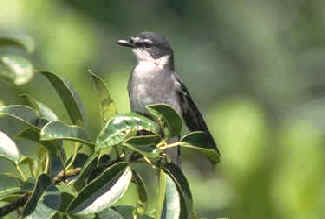
Ryukyu Minivets have been seen during FONT Japan Tours
in Kyushu, Amami, & Okinawa
CUCKOO-SHRIKE
The Cuckoo-Shrikes and the Minivets are in same family: CAMPEPHAGIDAE
- Black-winged Cuckoo-Shrike (Asakura-sanshokui)
(JAr) ______
Coracina melaschistos
WOODSWALLOW
- White-breasted Woodswallow (JAr)
______
Artamus leucorynchus
The White-breasted Woodswallow is essentially a resident in southeast Asia
and Australia, but it has occurred in Japan as a vagrant.
SHRIKES
- Bull-headed Shrike (Mozu) (*)
______ SS,FW HN:jan,feb,apr,may,jun,oct,nov HI:may
HK:jun KY:jan,feb,may,nov,dec AM:feb,dec
Lanius b. bucephalus
- Brown Shrike (Aka-mozu
= red-tailed shrike)
(JArw) (*) ______
SS,FW HN:nov
HI:may
OK:jan
Lanius cristatus
Lanius c. lucionensis (subspecies
that occurs on Okinawa)
Lanius c. superciliosus
(subspecies breeds on Hokkaido & Honshu, the "Japanese
Shrike")
- Tiger (or Thick-billed) Shrike (Chigo-mozu
= child shrike)
(*) ______ SS HI:may
Lanius tigrinus (monotypic)
- Long-tailed (or Rufous-backed)
Shrike (Takaago-mozu)
(JAr) (*) ______
FW KY:jan
Lanius s. schach
- Great Grey Shrike (O-mozu
= large shrike)
(*) (ph) ______ FW
HK:jan
Lanius excubitor bianchii
The Great Grey Shrike is
called the Northern Shrike in North America.
- Chinese Grey Shrike (O-kara-mozu =
large shrike of old China) (JAr)
______
Lanius sphenocercus
- Red-backed
Shrike (JAr) (ph) ______
Lanius c. collurio
The Red-backed Shrike has occurred as an accidental species in Japan,
where it has overwintered in Kyushu.
ORIOLE &
DRONGOS
- Black-naped Oriole (Korai-uguisu)
(JAr) (*) (ph)
______ SS
HI:may
Oriolus chinensis diffusus

A Black-naped Oriole during a FONT Japan Tour
on Hegura Island
- Black Drongo (Ochu)
(JAr) (*)
______ SS HI:may
Dicrurus macrocercus
(The subspecies in China is D. m. cathoecus; the subspecies endemic to
Taiwan is D. m. harterti.)
- Ashy Drongo (JAr) ______
Dicrurus leucophaeus
The Ashy Drongo is a resident in southeast Asia and a summer visitor in
eastern China. Overshoots have occurred in southern and offshore Japan,
with late-autumn records in Nansei Shoto.
- Hair-crested Drongo (JAr)
______
Dicrurus hottentottus
The Hair-crested Drongo is a resident in southeast Asia, and a summer
visitor in eastern China. Overshoots have occurred on offshore Japanese
islands.
CORVIDS
- Eurasian Jay (Kakesu = hang-nest)
(*) ______ SS,FW HN:jan,feb,apr,may,jun,oct
HK:jan,feb,may,jun,nov,dec KY:jan,feb,may,nov,dec
Garrulus glandarius
Garrulus g. brandtii (subspecies
on Hokkaido)
Garrulus g. japonicus (subspecies
on Honshu & Kyushu)
(2 other subspecies occur on other Japanese islands)
- Amami Jay (Ruri-kakesu)
(t3) (JAe) (*) (ph) ______ SS,FW
AM:jan,feb,may,jul,nov,dec
Garrulus lidthi
(monotypic)
The Amami Jay has also been called the Lidth's Jay.
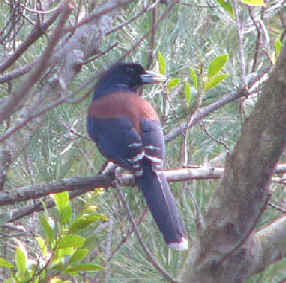
An Amami Jay photographed during a FONT Tour.
The species is endemic to that Japanese island,
and one smaller island nearby.
- Spotted Nutcracker
(Hoshi-garasu = star, or spotted crow) (*) ______
SS FW HN:may,jun,oct
Nucifraga caryocatactes japonica (in the
Northern
group)
- Azure-winged Magpie
(Onaga = long tail)
(*) ______ SS,FW HN:jan,feb,apr,may,jun,nov,dec
Cyanopica cyana japonica
- Oriental Magpie
(Kasasagi)
(JAi) (*) ______
FW HK:feb
KY:jan
Pica sericea
Recent evidence indicates that
both populations of what has been the Eurasian Magpie in eastern Asia,
the Kamchatka Magpie and the Oriental Magpie of
Amurland, Korea, Japan, & China, differ substantially enough in DNA
from western Eurasian birds to be considered a separate species. However,
their exact ranges and any morphological and vocal differences are still
unclear.
The Eurasian Magpie. Pica pica, was considered conspecific with the Black-billed
Magpie of North America, Pica hudsonia.
- Daurian Jackdaw (Kokumaru-garasu = black-ball
crow)
(*) ______ FW HN:jan KY:jan,feb,nov
Coloeus
(formerly Corvus) dauuricus (monotypic)
- Rook (Miyama-garasu =
mountain-country crow) (*)
______ SS,FW HN:jan HI:apr,may
HK:jan KY:jan,feb,nov,dec AM:dec
Corvus frugilegus pastinator
- Carrion Crow (Hashiboso-garasu = thin-billed
crow)
(*) ______ SS,FW HN:jan,feb,apr,may,jun,jul,oct,nov,dec
HI:apr,may HK:jan,feb,may,jun,nov,dec
KY:jan,feb,may,jul,nov,dec
Corvus corone orientalis
- Large-billed Crow
(Hashibuto-garasu =
thick-billed crow)
(*) ______ SS,FW HN:jan,feb,apr,may,jun,jul,oct,nov,dec
HI:apr,may HK:jan,feb,may,jun,nov,dec
KY:jan,feb,may,jul,nov,dec AM:jan,feb,may,jul,nov,dec OK:jan,feb,may,jul,nov
Corvus macrorhynchos
Corvus m. japonensis (subspecies
on Hokkaido, Honshu, Kyushu)
Corvus m. connectens (subspecies
on Amami & Okinawa)
(1, maybe 2, other subspecies occur on various Japanese
islands)
Corvus m. osai (subspecies on the Yaeyama Islands)
The Large-billed Crow was considered conspecific with the Jungle
Crow of southern Asia, Corvus levaillantii.
Proposed taxonomy would be: Japanese Crow, Corvus j.
japonensis & C. j, connectens & C. m.
osai.
- Northern Raven (Watari-garasu = migrant crow)
(JAr) (*) (ph) ______ FW HK:jan,feb,dec
Corvus corax kamtschaticus
TITS & PENDULINE TIT
- Marsh Tit (Hashibuto-gara = thick-billed
tit) (*)
______ SS,FW HK:jan,feb,may,jun,nov,dec
Poecile
(formerly Parus) palustris hensoni
- Willow Tit (Ko-gara = little tit)
(*) ______ SS,FW HN:jan,feb,apr,may,jun,oct
HK:jan,feb,may,jun
KY:jan,may,nov
Poecile (formerly Parus) montanus restrictus
(Poecile m. sachalinensis,
(a slightly paler subspecies, from Sakhalin Island, that may occur
on Hokkaido as a vagrant.
- Varied Tit (Yama-gara
= mountain tit)
(JAneb) (*) ______ SS,FW HN:jan,feb,apr,may,jun,jul,nov,dec
HI:may(once) HK:jan,feb,may,dec
KY:jan,feb,may,nov,dec AM:jan,feb,may,nov,dec
OK:jan,feb,may,jul,nov
Poecile
(formerly Parus) varius
Poecile v. varius (subspecies
on Hokkaido, Honshu, Kyushu)
Poecile v. amami (subspecies
on Amami & Okinawa)
(Other subspecies occur on various Japanese islands,
Poecile v.
yakushimensis also on Amami Is. as a non-breeding visitant)
- Coal Tit (Hi-gara = sun tit)
(*) ______ SS,FW HN:jan,feb,apr,may,jun,oct HI:apr(once)
HK:jan,feb,may,jun,dec KY:jan,may,nov,dec
Periparus
(formerly Parus) ater insularis
Eastern Great Tit (or
"Japanese Tit")
(Shiju-kara = "forty"
titmouse, referring to the call note)
(*) ______ SS,FW HN:jan,feb,apr,may,jun,oct,nov,dec
HK:jan,feb,may,jun,nov,dec KY:jan,feb,may,jul,nov,dec
AM:jan,feb,may,jul,nov,dec
OK:jan,feb,may,nov
Parus minor
Parus m. minor
(subspecies on Hokkaido, Honshu, Kyushu)
Parus m. amamiensis (subspecies
on Amami)
Parus m. okinawae (subspecies
on Okinawa)
The Eastern Great Tit was considered conspecific with the Northern
Great Tit of western Eurasia, Parus major.
Southern Great Tit ______
Parus cinereus nigriloris
The Southern Great Tit occurs in Japan in southern Nansei Shoto on the
islands of Ishigaki-jima and Iriomote-jima.
Azure Tit (JAr) ______
Cyanistes cyanus
The Azure Tit has occurred in Japan as a vagrant in Hokkaido.
Chinese Penduline Tit
(Tsurisu-gara)
(*) ______ FW KY:jan,feb
Remiz consobrinus
The Chinese Penduline Tit
was considered conspecific with other Penduline Tits across Eurasia
- now 4 species.
WAXWINGS
Japanese Waxwing (Hi-renjaku = red-flocking
sparrow)
(nt) (*) ______ SS,FW HN:jan,apr HI:may
HK:jan,may KY:jan,nov AM:jan
Bombycilla japonica
(monotypic)
The Japanese Waxwing is not
a Japanese breeder.
Bohemian Waxwing (Ki-renjaku
= yellow-flocking sparrow)
(*) ______ SS,FW HN:may HK:jan AM:jan
Bombycilla garrulus (centralasiae)
SWALLOWS & MARTINS
Barn Swallow (Tsubame) (*)
(ph) ______ SS,FW
HN:jan,feb,apr,may,jun,jul,oct HI:apr,may
HK:may KY:jan,feb,may,jul,nov,dec AM:jan,feb,dec
OK:jan,feb,may
Hirundo rustica
(2 subspecies recorded in
Japan: Hirundo r. gutturalis
(mostly),
and Hirundo r. saturata)
Pacific Swallow
(Ryukyu-tsubame)
(*) ______ SS,FW
AM:jan,feb,may,jul,nov,dec
OK:jan,feb,may,jul,nov NS:jan,may
Hirundo tahitica namiyae
Red-rumped Swallow
(Koshiaka-tsubame = red-rumped
swallow)
(*) ______ SS,FW HN:may HI:may KY:nov
AM:may
Cecropis
(formerly Hirundo)
daurica japonica
Sand Martin (or Bank
Swallow) (Shodo-tsubame
- burrow swallow) (*) ______
SS HN:apr,may
HI:apr,may HK:jun
Riparia riparia iijimae
Grey-throated Martin (JAr)
______
Riparia chinensis
The Grey-throated Martin of southern Asia has occurred as an accidental in
southern Japan.
Asian House Martin
(Iwa-tsubame
= rock swallow)
(*) ______ SS,FW
HN:apr,may,jun HK:may,jun
KY:jan,feb,may,nov AM:jan
OK:jan,feb
Delichon d. dasypus
The Asian House Martin
was considered conspecific with the Northern House Martin of Europe
and east into Siberia.
Northern House Martin (JAr)
______
Delichon urbicum
Northern House Martins from Siberia occur as rare migrants in Japan. Some
winter in southeast China.
LONG-TAILED TIT
Long-tailed Bushtit
(Enaga
= long handle)
(*) ______ SS,FW HN:jan,feb,apr,may,jun,oct,nov HK:jan,may,dec
KY:jan,may,nov,dec
Aegithalos caudatus
Aegithalos c. japonicus
(subspecies on Hokkaido)
Aegithalos c. trivirgatus
(subspecies on Honshu)
Aegithalos c. kiusiuensis (subspecies on Kyushu)
A.c. japonicus
in the Caudatus
group, with head & throat white
A.c.
trivirgatus
& kiusiuensis
in the Europaeus
group, with
head having
dark lateral crown stripes
The Long-tailed Bushtit has been called Long-tailed Tit.
LARKS
Greater Short-toed Lark (JAr)
(Hime-kotenshi =
Sakhalin small lark) (*) ______
SS HI:apr,may
Calandrella cinerea longipennis
Asian Short-toed Lark (Ko-hibari) (JAr)
______
Calandrella cheleensis
Eurasian Skylark (Hibari) (*)
______ SS,FW
HN:jan,feb,apr,may,jun,oct,nov
HI:apr HK:jan,jun KY:jan,feb,may,nov,dec
Alauda arvensis japonica ("Japanese
Skylark": a resident in much of Japan)
Alauda arvensis pekinensis (HI)
(A. a. pekinensis & A. a. lonnbergi
are subspecies from mainland Asia that have occurred in Japan)
Horned
(or Shore) Lark (Hama-hibari
= shore lark)
(JAr) ______
Eremophila alpestris
Bimaculated Lark (Kubiwa kotenshi =
collared angel) (JAr) ______
Melanocorypha bimaculata
The Bimaculated Lark has been accidental in winter in the
Ryukyu Islands, from December to April.
It is a central Asian species.
Mongolian Lark (JAr) ______
Melanocorypha mongolica (monotypic)
BULBULS
Brown-eared Bulbul (Hiyodori)
(JAneb) (*) (ph) ______ SS,FW
HN:jan,feb,apr,may,jun,jul,oct,nov,dec
HI:may HK:jan,feb,may,jun,nov,dec KY:jan,feb,may,jul,nov,dec
AM:jan,feb,may,jul,nov,dec OK:jan,feb,may,jul,nov
Microscelis
(formerly
Hypsipetes)
amaurotis
Microscelis a. amaurotis (subspecies
on
Hokkaido, Honshu, & Kyushu)
Microscelis a. ogawae (subspecies
on Amami)
Microscelis a. pryeri (subspecies
on Okinawa)
(other subspecies occur on other, smaller, Japanese
islands & in Taiwan)

Brown-eared Bulbul, photographed during the FONT Jan/Feb 2009 tour in Japan
(photo by Karl Frafjord)
Light-vented Bulbul (Shirogashira)
(*) ______ SS,FW
OK:jan,feb,may,jul,nov
Pycnonotus
sinensis orii
Himalayan Black Bulbul (JAr)
______
Hypsipetes leucocephalus
The Himalayan Black Bulbul is a summer visitor in eastern Asia. It has
occurred as an accidental in offshore Japan.
OLD WORLD WARBLERS
Zitting Cisticola
(Sekka = under the snow)
(*) ______ SS,FW HN:apr,may,jun
KY:jan,may,jul,nov,dec AM:jan,feb,may,jul,nov,dec OK:jan,feb,may,jul,nov
Cisticola juncidis brunniceps
The Zitting Cisticola
was called the Fan-tailed Warbler, but there's a species so-named
in Mexico, totally unrelated; also, now the cisticolas are not in
the same family as the Old World Warblers.
Plain Prinia (JAr) ______
Prinia inornata
The Plain Prinia of eastern China & Taiwan has occurred in Japan as an
accidental in Okinawa.
Asian Stubtail
(Yabusame = bamboo shark) (*) ______
SS HN:jun
HI:apr HK:may,jun KY:may
Cettia s. squameiceps
The Asian Stubtail was called the Short-tailed
Bush Warbler.
Japanese Bush Warbler
(Uguisu)
(*) (ph) ______ SS,FW HN:jan,feb,apr,may,jun,jul,oct,nov
HI:apr,may KY:jan,feb,may,jul,nov,dec AM:jan,feb,nov,dec
OK:jan,feb,may,jul,nov
Cettia diphone
Cettia d. sakhalinensis (subspecies
on Honshu & Kyushu, non-breeding, winter)
Cettia d. cantans (subspecies
on Hokkaido, Honshu, Kyushu, breeding)
Cettia d. riukiuensis (subspecies
on Amami & Okinawa)
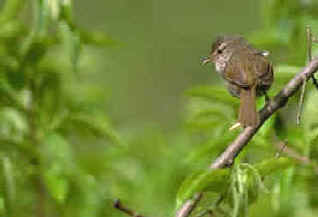
The Japanese Bush Warbler seen and heard during FONT Japan Tours
in the Spring & the Winter
Korean Bush Warbler (JAr)
______
Cettia canturians borealis
The Korean Bush Warbler winters in southern Nansei Shoto
on Yaeyama Island.
Lanceolated (Grasshopper) Warbler
(Makino-sennyu = pasture grasshopper
warbler) (*) ______
SS HK:jun
Locustella lancolata hendersonii
Gray's (Grasshopper) Warbler
(Ezo-sennyu = Hokkaido hermit, or gnome) (*) ______ SS
HI:may
Locustella fasciolata amnicola
The subspecies of the Gray's Warbler, L. f. amnicola,
is sometimes considered distinct as the Stepanyan's Warbler,
summering on Hokkaido, the southern Kuril Islands, and Sakhalin.
Middendorff's Warbler (Shima-sennyu
= island grasshopper warbler)
(JAr) ______
Locustella ochotensis
Pallas's (Grasshopper) Warbler
(Shiberia-sennyu = Siberian grasshopper warbler) (JAr) ______
Locustella certhiola
Pleske's Warbler (t3) (JAr)
______
Locustella pleskei
Another name of the Pleske's Warbler has been Styan's
Grasshopper Warbler.
Marsh Grassbird (O-sekka)
(t3) (*) ______
SS HN:apr,may
Megalurus p. pryeri
The Marsh Grassbird has also been called the Japanese
Marsh Warbler.
Black-browed (or Schenk's)
Reed Warbler
(Ko-yoshikiri = lesser reed-cutter) (*) ______
SS HI:may
HK:jun
Acrocephalus bistrigiceps (monotypic)
Oriental Reed Warbler (O-yoshikiri
= large reed-cutter) (*) ______
SS HN:apr,may,jun
HI:apr,may
Acrocephalus orientalis
The Oriental Reed Warbler was considered conspecific
with the Great Reed Warbler of Europe, Acrocephalus orientalis.
Thick-billed Warbler (Hasibuto-oyoshikiri
= big-billed large reed-cutter) (JAr) ______
Acrocephalus aedon rufescens
Streaked Reed Warbler (JAr)
______
Acrocephalus sorghophilus
The Streaked Reed Warbler has occurred as an accidental species in
southern Japan, on the island of Yonaguni-jima.
Paddyfield Warbler (JAr)
______
Acrocephalus agricola
The Paddyfield Warbler has occurred as an accidental in Japan.
Blyth's Reed Warbler (JAr)
______
Acrocephalus dumetorum
The Blyth's Reed Warbler has occurred as an accidental in Japan in
Hokkaido and Okinawa.
Booted Warbler (JAr)
______
Hippolais caligata
The Booted Warbler has occurred as an accidental in Japan.
Eastern Crowned Warbler (Sendai-mushikui
= Sendai insect-eater)
(*) (ph) ______
SS HN:may,jun
HI:apr,may HK:may,jun
Phylloscopus coronatus
(monotypic)
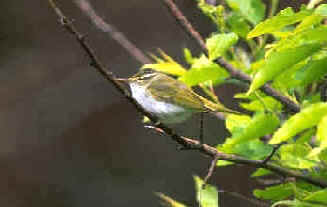
The Eastern Crowned Warbler, found during FONT Japan Tours in the Spring
Sakhalin Leaf Warbler
(Ezo-mushikui = Hokkaido insect-eater) (*) ______
SS HN:may
HI:apr,may HK:may,jun
Phylloscopus borealoides (monotypic)
The Sakhalin Leaf Warbler was part of the Pale-legged Leaf
Warbler.
Pale-legged Leaf Warbler (JAr)
______
Phylloscopus tenellipes
The Pale-legged Leaf Warbler breeds only in continental Asia, from the
Amur River south to northern Korea. It is a rare migrant in Japan.
Ijima's Leaf Warbler (Ijima-mushikui = Ijima's insect-eater) (t3)
(JAeb) ______
Phylloscopus ijimae (monotypic)
The Ijima's Leaf Warbler was historically included in the Eastern and Western Crowned Warblers and in
the Pale-legged Leaf Warbler.
Arctic Warbler
(Meboso-mushikui = Meboso
insect-eater)
(*) ______ SS,FW AM:jan,feb,nov,dec HI:may HN:jan
Phylloscopus borealis
Several subspecies of the Arctic Warbler have
been described based on subtle morphological characteristics, but the
taxonomy varies considerably among different authors. Here, we give the
following:
Phylloscopus b. borealis, breeds in far eastern Russia. It
winters in southeast Asia and Indonesia.
Phylloscopus borealis kennicotti, breeds in western &
central Alaska. It migrates through eastern Asia including Japan &
Taiwan. It winters in Nansei Shoto in Japan, and in the Philippines and
Indonesia.
And the following two species we split here from the Arctic
Warbler:
Japanese Leaf Warbler ______
Phylloscopus xanthodryas
The Japanese Leaf Warbler breeds in Japan except on Hokkaido, where
the following species breeds.
This, and the previous and the following species, move through Japan
during their northward and southward migrations.
Kamchatka Leaf Warbler (*)
______ SS
HI:may
Phylloscopus examinandus
The Kamchatka Leaf Warbler breeds on at least the southern part of
the Kamchatka Peninsula in eastern Siberia, and on Sakhalin, the Kurile
Islands, and in Japan on Hokkaido.
It winters, as do the previous two species, in the Philippines and
Indonesia, as well as elsewhere in southeast Asia.
Yellow-browed Warbler (Kimayu-mushikui)
(JAr) (*) (ph) ______ FW SS
HI:may AM:jan,nov
Phylloscopus inornatus (monotypic)
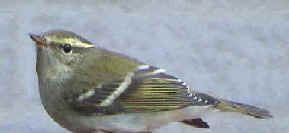
Yellow-browed
Warbler
Dusky Warbler (Muji-sekka)
(JAr) (*) ______
SS HI:may
Phylloscopus f. fuscatus
Radde's Warbler (JAr) (Karafuto-muji-sekka)
(*) ______ SS HI:may
Phylloscopus schwarzi (monotypic)
Siberian Chiffchaff (JAr) (*)
______ SS HI:may
Phylloscopus tristus
The Siberian Chiffchaff is an accidental migrant in offshore
Japan, and rare in Japan in the winter.
Mandelli's Leaf Warbler (JAr)
______
Phylloscopus humei mandellii
The Mandell's Leaf Warbler is part of the Hume's Warbler, closely
related to the Yellow-browed Warbler.
Pallas's Leaf Warbler
(Karafuto-mushikui)
(JAr) ______
Phylloscopus proregulus
Wood Warbler
(Mori-mushikui) (JAr) ______
Phylloscopus sibilatrix
Willow Warbler (Kita-yanagi-mushikui)
(JAr) ______
Phylloscopus trochilus
The Willow Warbler is probably an annual offshore migrant in
Japan from September to November.
Tickell's Leaf Warbler (JAr)
______
Phylloscopus affinis
The Tickell's Leaf Warbler, that breeds in the Himalayas and
western China, is an accidental in offshore Japan.
Greenish Warbler (JAr) ______
Phylloscopus trochiloides
The Greenish Warbler, that breeds in Eurasia east to central China, has
occurred as an accidental in offshore Japan.
Two-barred Greenish Warbler (JAr)
______
Phylloscopus (trochiloides) plumbeitarsus
The Two-barred Greenish Warbler is said to be the eastern subspecies of
the Greenish Warbler, but some say that it is possibly a full species.
It occurs as an accidental in offshore Japan.
Lesser Whitethroat (JAr)
______
Sylvia curruca blythi
The Lesser Whitethroat has occurred as an accidental in Japan.
LAUGHING THRUSHES & LEIOTHRIX
Moustached Laughing Thrush (JAi) ______
(now widespread on the island of Shikoku)
Garrulax cineraceus
In Japan, the Moustached Laughing Thrush is now
widespread on the island of Shikoku.
Chinese Hwamei (JAi) (*)
______ FW HN:oct
Garrulax canorus
The Chinese Hwamei is now well established in central &
southern Japan.
Red-billed Leiothrix
(Soushicho)
(JAi) (*) ______ SS,FW KY:jan,may
Leiothrix lutea
PARROTBILLS
Bearded Reedling (Higegara
= bearded titmouse) (JAr) ______
Panurus biarmicus russicus
The Bearded Reedling occurs as a vagrant in Japan in the
winter.
Vinous-throated Parrotbill (JAr)
______
Paradoxornis webbianus
A common resident in Korea and elsewhere in eastern continental Asia,
the Vinous-throated Parrotbill has occurred as an accidental in
offshore Japan.
WHITE-EYES
Japanese White-eye
(Mejiro
= white eye)
(*) ______ SS,FW HN:jan,feb,apr,may,jun,jul,oct,nov,dec
HI:apr,may KY:jan,feb,may,jul,nov,dec
AM:jan,feb,may,jul,nov,dec
OK:jan,feb,may,jul,nov
Zosterops japonica
Zosterops j. japonica (subspecies
on
Honshu, Kyushu)
Zosterops j. yesoensis (subspecies
on Hokkaido & the southern Sakhalin
Islands)
Zosterops j. loochooensis (subspecies
on Amami & Okinawa)
(other subspecies occur on various, smaller, Japanese islands: Z. j.
stejnegeri & Z. j. alani)
Chestnut-flanked White-eye (Chosen-mejiro)
(JAr) ______
Zosterops erythropleura
Bonin Honeyeater (Meguro) (t3) (JAe) ______
Apalapteron
(or
Zosterops) familare hahasima: subspecies on Haha Island
Another subspecies, the nominate, A. f. familiare, is now
presumed extinct. It was on the islands of Mukojima and Chichijima.
Apalapteron familare has
also been called the Bonin Islands Honeyeater.
Another name has been the Bonin White-eye.
GOLDCREST
Goldcrest (Kikuitadaki
= chrysanthemum crown)
(*) (ph)
______
SS,FW HN:jan,may
HK:jan,jun,nov,dec
Regulus regulus japonensis
WREN
Eurasian Wren
(Misosazai)
(*) ______ SS,FW HN:jan,feb,apr,may,jun
HK:jan,jun,dec
KY:jan,may,jul,nov
Troglodytes
(or Nannus) troglodytes fumigatus
NUTHATCHES
Eurasian Nuthatch
(Goju-kara
= "fifty tit")
(*) (ph) ______ SS,FW HN:jan,feb,apr,may,jun,oct
KY:jan,feb,may,nov
Sitta europaea
Sitta e. amurensis (subspecies
on Honshu)
Sitta e. roseilia (subspecies on Kyushu)
(this species in the Europaea group)
Siberian Nuthatch (*) (ph)
______ SS,FW HK:jan,feb,may,jun,nov,dec
Sitta asiatica
(this species in the Europaea group)
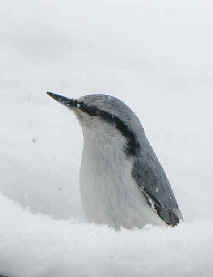
A Siberian Nuthatch photographed in Hokkaido
Eurasian Treecreeper (Kivashiri = tree runner)
(*) ______ FW HN:jan HK:jan,feb,nov
Certhia familiaris
Certhia f. daurica (subspecies
on Hokkaido)
Certhia f. japonica (subspecies
on Honshu)
(these 2 subspecies in the northern Familiaris group)
STARLINGS & MYNAS
Common Starling (Hoshi-mukudori) (JAr)
(*) (ph) ______ FW KY:jan,feb,nov OK:jan,feb
Sturnus vulgaris poltaratskyi
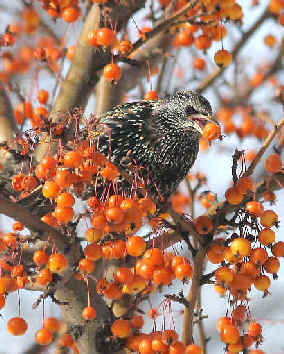
The Common Starling is 1 of 6
species of starlings we've seen during FONT tours in Japan.
Occurring there in the winter, it is a
rarity.
(photo by Doris Potter)
White-cheeked (or Grey)
Starling (Mukudori = bird of the muku tree) (*) ______ SS,FW HN:jan,feb,apr,may,jun,oct,nov,dec HI:apr,may
HK:feb KY:jan,feb,may,nov,dec AM:dec OK:jan,feb,may
Sturnus cineraceus (monotypic)
Another name for the White-cheeked, or Gray,
Starling has been Ashy Starling.
White-shouldered Starling (Kara-mukudori = starling
of old China)
(JAr) (*) ______ FW KY:jan OK:jan,feb
Sturnus sinensis (monotypic)
The White-shouldered Starling has also
been called the Gray-backed Starling or Myna.
Red-billed Starling (Gin-mukudori) (JAr) (*) ______ FW
KY:jan OK:feb
Sturnus sericeus (monotypic)
The Red-billed Starling has also been called the
Silky Starling.
Chestnut-cheeked Starling (Ko-mukudori
= little starling)
(nt) (JAeb) (*) ______ SS
FW HN:may,jun,oct HI:may
Sturnus philippensis (monotypic)
The Chestnut-cheeked Starling has also been called the Violet-backed
Starling or Myna.
Daurian (or Purple-backed)
Starling (Shiberia-mukudori)
(JAr) (*) ______
SS HI:may
Sturnus sturninus (monotypic)
Asian Pied Starling (JAr)
______
Sturnus contra
The Asian Pied Starling is a resident in southern Asia from India to
Indonesia.
There are established feral populations of the species in central Honshu.
Rosy Starling (JAr) ______
Pastor roseus
The Rosy Starling breeds in central Eurasia, and winters in
southern Asia.
It has strayed to Japan.
Crested Myna (Hakkacho) (JAi)
(*) ______ FW HN:jan
Acridotheres cristatellus
Javan Myna (JAi) ______
Acridotheres javanicus
The Javan Myna is introduced in Japan in central Honshu, where
feral populations are now established. In it natural range, the species is
endemic to Java.
Bank Myna (JAi) ______
Acridotheres ginginianus
The Bank Myna is introduced in Japan, where it is found
locally.
Asian Glossy Starling (JAr)
______
Aplonis panayensis
The Asian Glossy Starling is an accidental in southern Japan in
the early spring in March & April.
THRUSHES
White-browed Shortwing (JAr)
______
Brachypteryx montana sinensis
The subspecies of the White-browed Shortwing, B.
m. sinensis, lives in southeast China.
It has occurred (once) in Japan on Hegura Island. The bird was said to be
possibly an escapee.
Blue Rock Thrush (Iso-hiyodori = beach bulbul)
(*) ______ SS,FW HN:jan,feb,apr,may,oct HI:apr,may
KY:jan.feb,nov,dec AM:jan,feb,may,jul,nov,dec OK:jan,feb,may,jul,nov
NS:jan,may
Monticola solitarius philippensis (the "Red-bellied
Rock Thrush")
White-throated Rock Thrush (Hima-isohiyo)
(JAr) (*) (ph) ______ SS
HI:may
Monticola gularis
(monotypic)

Very much a rarity in Japan, this White-throated
Rock Thrush
was found on Hegura Island during a FONT tour in May 2005.
Rufous-tailed
(or White-backed) Rock
Thrush (Koshijiro-isohiyo) (JAr) ______
Monticola saxatilis
White's (Ground)
Thrush (Tora-tsugumi = tiger thrush) (*) ______ SS,FW HI:feb,apr,may KY:jan AM:jan,feb,dec
Zoothera aurera toratugumi
The White's Ground Thrush was considered conspecific
with the Scaly Ground Thrush of southeast Asia.
Amami (Ground) Thrush (O-tora-tsugumi)
(t1) (JAe) (*) ______ SS,FW
AM:jan,may,jul,nov,dec
Zoothera amami (monotypic)
Siberian (Ground) Thrush
(Mamijiro = white eye-brow) (*) (ph) ______ SS
HN:may,jun
HI:may
Zoothera sibirica davisoni
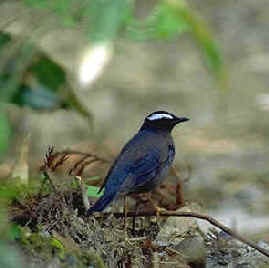
A male Siberian Thrush
Kittlitz's (or Bonin
Islands)
Thrush (Ogasawara-gabicho) (JAe) ______
(now
extinct)
Zoothera
(formerly Cichlopasser) terrestris
Gray-cheeked Thrush (JAr)
______
Catharus minimus
Brown-headed Thrush (Akahara = red-belly) (JAneb) (*) ______
SS,FW HN:jan,feb,apr,may,jun,nov,dec HI:apr,may
HK:may,jun KY:nov,dec AM:jan,feb,nov,dec
OK:jan
Turdus c. chrysolaus
The Brown-headed Thrush has been called Brown
Thrush.
Pale Thrush (Shirohara = white-belly)
(*) ______ SS,FW HN:jan,feb,apr,may,nov,dec HI:apr,may
KY:jan,feb,nov,dec AM:jan,feb,nov,dec OK:jan,feb,nov
Turdus pallidus
(monotypic)
Eye-browed (or Grey-headed)
Thrush (Mamichajinai = brown eye-browed bird) (*) ______ SS,FW HN:may,oct HI:may
HK:may KY:nov
Turdus obscurus (monotypic)
Dusky Thrush (Tsugumi)
(JArs) (*) (ph) ______ SS,FW
HN:jan,feb,apr,may,jun,nov,dec HI:apr,may
HK:jan,feb,dec KY:jan,feb,nov,dec AM:jan,feb,nov,dec OK:jan,feb,nov
Turdus eunomus (monotypic)
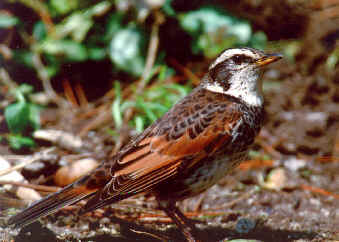
A Dusky Thrush photographed during
a FONT tour in Japan
Naumann's Thrush (JAr) (*) (ph) ______ SS,FW
HN:jan HI:apr,may AM:feb
Turdus naumanni (monotypic)
The Naumann's Thrush was considered conspecific with the Dusky
Thrush.
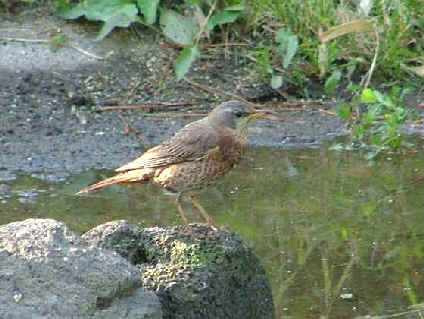
A Naumann's Thrush during a FONT Japan Tour
on Hegura Island
Japanese (Grey) Thrush
(Kuro-tsugumi = black thrush) (*) ______
SS,FW HN:apr,may
HI:apr,may HK:may AM;dec
Turdus cardis (monotypic)
The Japanese Thrush has been called the Grey Thrush, but
there's another species with that name in Africa.
The name Japanese Thrush notwithstanding, the species is not
endemic to Japan, occurring also in China &
Korea.
Izu Islands Thrush
(Akakokko) (t3) (JAe) ______
Turdus calaenops
Grey-backed Thrush
(Kara-akahara) (JAr) ______
Turdus hortulorum
Red-throated Thrush (Nodoguro-tsugumi)
(JAr) ______
Turdus ruficollis
The Red-throated Thrush was part of the Dark-throated
Thrush. Both species are Asian.
Black-throated Thrush (JAr)
______
Turdus atrogularis
The Black-throated Thrush breeds in central Asia. It has been
an accidental in Japan.
Eurasian Blackbird (Kuro-utadorui)
(JAr) ______
Turdus merlula
Fieldfare (Nohara-tsugumi)
(JAr)
______
Turdus pilaris
There are several winter records of the Fieldfare in Japan.
Redwing (Wakiaka-tsugumi
= red-flanked thrush) (JAr)
(ph) ______
Turdus iliacus
The Redwing has been an accidental in Japan in the winter.
Song Thrush
(Uta-tsugumi) (JAr)
______
Turdus philomelos
The Song Thrush has been an accidental in Japan in the winter.
Mistle Thrush
(Yadorigi-tsugumi) (JAr) ______
Turdus viscivorus
There are several winter records of the Mistle Thrush in Japan.
European Robin (JAr) (ph)
______
Erithacus rubecula
The European Robin has been an accidental in Japan from May to
November.
Japanese Robin (Komadori
= steed bird)
(JAneb) (*) ______
SS HN:apr,may
HI:apr HK:may KY:may
Erithacus a. akahige
Ryukyu Robin (Akahige = red whiskers) (nt)
(*) (ph) ______ SS,FW
AM:jan,feb,may,nov,dec
OK:jan,feb,may,jul,nov
Erithacus komadori
Erithacus k. komadori (on
Amami)
Erithacus k. namiyei
(on Okinawa)
From the Japanese common
names for
the Japanese & Ryukyu Robins, notice that
the
scientific names for the 2 species were erroneously applied.
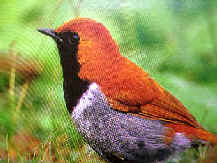
Ryukyu Robin, seen during FONT Japan Tours in Amami & Okinawa
Swinhoe's (or Rufous-tailed) Robin
(Shima-goma = striped steed) (JAr) (*)
(ph) ______ SS HI:may
Luscinia sibilans
(monotypic)
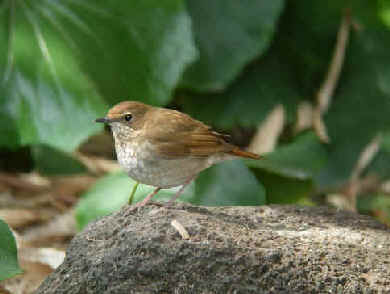
A Swinhoe's, or Rufous-tailed, Robin during a
FONT Japan Tour on Hegura Island
Siberian Rubythroat
(No-goma = field steed) (*) (ph) ______
SS,FW HI:apr,may HK:jun AM:jan
Luscinia calliope camtschhatkensis
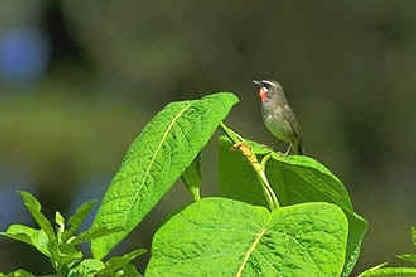
A Siberian Ruby-throat during a FONT Japan
Tour on Hegura Island
Bluethroat (Ogawa-komadori
= Ogawa's robin)
(JArw) (*) (ph) ______ SS,FW
HI:may AM:jan
Luscinia s. svecicus
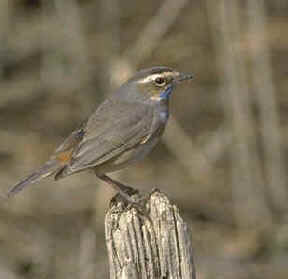
The Bluethroat was one of the
migrants seen on
Hegura Island during the FONT Japan spring tour
in 2007.
Siberian Blue Robin
(Ko-ruri = lesser azure) (*) ______ SS
HN:may,jun HI:may
Luscinia cyane bachaiensis
Red-flanked Bluetail (Ruri-bitaki = azure chat) (*)
(ph) ______ SS,FW HN:jan,feb,apr,may,dec HI:apr,may
HK:nov
KY:jan,nov AM:jan,dec OK:jan
Luscinia
(formerly
Tarsiger) c. cyanurus
What was the Himalayan population of
the Red-flanked Bluetail, the Orange-flanked Bush Robin, is
no longer included in Luscinia cyanurus.

A Red-flanked Bluetail
photographed during a FONT tour in Japan
Daurian Redstart
(Jo-bitaki = common chat)
(*) ______ SS,FW HN:jan,feb,apr,may,oct,nov HI:apr,may
HK:jan,dec KY:jan,feb,nov,dec AM:jan,nov,dec
OK:jan,feb,nov
Phoenicurus a. auroreus
Black Redstart (Kuro-jo-bitaki)
(JAr) (*) ______ SS
HI:apr
Phoenicurus ochruros phoenicuroides
Common Redstart (JAr) ______
Phoenicurus p. phoenicurus
The Common Redstart is normally in western & central
Eurasia.
The subspecies P. p. phoenicurus
has occurred as an accidental in offshore Japan in October & November,
and in the nearby Kuril Islands.
Siberian Stonechat
(No-bitaki = field chat) (*) ______ SS
HN:apr,may HI:apr,may
HK:may,jun
Saxicola stejnegeri
Pied Bushchat (Kuro-ko-bitaki)
(JAr) ______
Saxicola caprata
The Pied Bushchat has been an accidental in southern Japan in
the winter, occurring from January to March.
Grey Bushchat (Yamazaki-hitaki)
(JAr) ______
Saxicola ferrea
The Grey Bushchat is mostly a resident, or a local migrant, in
China. It has occurred as an accidental in offshore Japan.
Whinchat (JAr) ______
Saxicola rubetra
The Whinchat, of mostly western Eurasia, has occurred as an
accidental in Japan.
WHEATEARS
Desert Wheatear (Sabaku-hitaki)
(JAr) (*) (ph) ______
FW
Oenanthe d. deserti
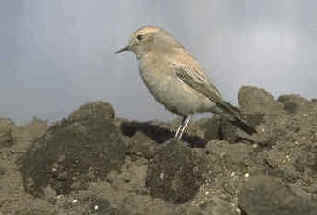
This Desert Wheatear was
seen in Tokyo during
one of the FONT Japan winter tours.
The species is a rarity in Japan.
Pied Wheatear
(Seguro-sabaku-hitaki) (JAr) (*)
______ SS HI:may
Oenanthe p. pleschanka
Isabelline Wheater
(Inaba-hitaki = Inaba chat) (JAr) (*) ______
SS HI:may
Oenanthe isabellina
Inaba was an old province in Japan, in southern Honshu, in an area
that is today the eastern part of the Tottori prefecture.
A specimen of Oenanthe isabellina
was taken there back sometime between 1905 and 1910.
Northern Wheatear (Hashiguro-hitaki)
(JAr) (ph) ______
Oenanthe o. oenanthe
The Northern Wheatear has occurred in Japan from Hokkaido to
Tsushima, and on Ogasawara and Iwo Islands.
OLD WORLD FLYCATCHERS
Blue-and-white Flycatcher
(O-ruri = large azure) (*) ______
SS HN:may,jun
HI:apr,may HK:may,jun KY:may
Cyanoptila c. cyanomelana
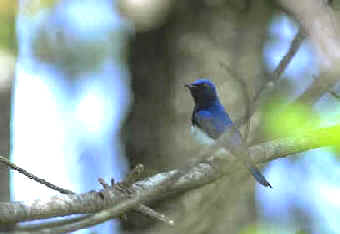
The Blue-and-white Flycatcher, seen & heard
during FONT Japan Tours in the Spring
Asian Brown Flycatcher
(Ko-same-bitaki = small shark flycatcher) (*) ______
SS
HN:may HI:apr,may HK;jun
Muscicapa d. dauurica (formerly M. latirostris)
Dark-sided Flycatcher (Same-bitaki
= shark flycatcher)
(*) ______
SS HN:may,oct
HI:may HK:jun
Muscicapa s. sibirica
The Dark-sided Flycatcher was called Siberian
Flycatcher. Another name that has been applied to the Dark-sided
Flycatcher has been Sooty Flycatcher, which is
inappropriate, however, as there's a bird so-named in
Africa.
Gray-streaked
Flycatcher (Ezo-bitaki = Hokkaido
flycatcher) (*)
______ SS HI:may
Muscicapa griseisticta (monotypic)
Taiga Flycatcher (Ojiro-bitaki)
(JAr) (*) ______
SS HI:may
Muscicapa albicilla (monotypic)
The Taiga Flycatcher was part of the Red-breasted
Flycatcher, Muscicapa parva, which
has also occurred as an accidental in Japan.
Red-breasted Flycatcher (JAr)
______
Muscicapa parva
Ferruginous Flycatcher
(Miyama-bitaki) (JAr) ______
Muscicapa ferriginea
The Ferruginous Flycatcher is a summer visitor in China,
Taiwan, and it winters in southeast Asia.
It is nearly an annual vagrant in southern Japan in March &
April.
Mugimaki Flycatcher (Mugimaki = wheat-sower) (JAr) (*) ______ SS,FW HI:may KY:jan
Ficedula mugimaki (monotypic)
Narcissus Flycatcher (Ki-bitaki
= yellow flycatcher)
(JAneb) (*) (ph) ______ SS
HN:may HI:apr,may HK:jun KY:may
Ficedula narcissina (monotypic)
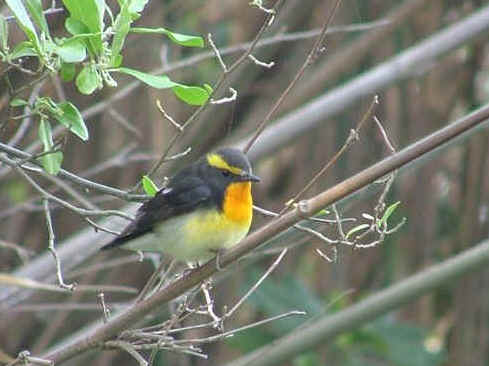
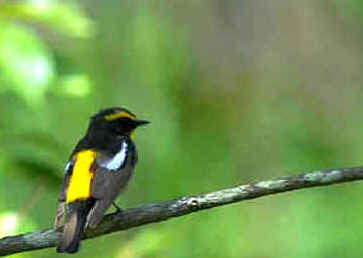
Two photos above of Narcissus Flycatchers, one of the nicest birds
to be seen during FONT Japan Tours in the Spring
Ryukyu Flycatcher (Ryukyu
Ki-bitaki) (t2) (JAe) (*) ______
SS,FW
AM:jan,may,nov OK:jan,feb
Ficedula owstoni
(monotypic)
The Ryukyu Flycatcher was considered part of the Narcissus
Flycatcher.
Yellow-rumped (or
Tricolored)
Flycatcher (Mamijiro-ki-bitaki)
(JAr) (*) (ph) ______ SS HI:may
Ficedula zanthopygia (monotypic)
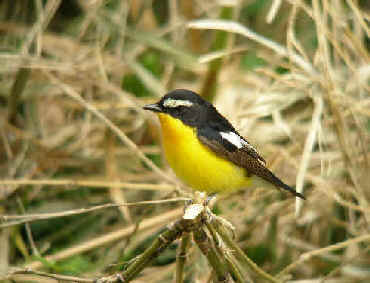
A Yellow-rumped Flycatcher during a FONT
Japan Tour on Hegura Island
Chinese Flycatcher (JAr)
______
Ficedula elisae (monotypic)
European Pied Flycatcher (JAr)
______
Ficedula hypoleuca
The European Pied Flycatcher has occurred as an accidental in
Japan in October.
Vivid Niltava (JAr) ______
Niltava vivida
The Vivid Niltava has
occurred as an accidental in southern Nansei Shoto on the islands of
Okinawa and Yonaguni-jima.
MONARCH
Japanese Paradise Flycatcher
(Sankocho = bird of three rays) (nt) (JAneb)
(*) ______
SS HI:may
KY:may AM:may OK:may
Terpsiphone atrocaudata illex (subspecies on Kyushu & Nansei Shoto islands)
Terpsiphone a.
atrocaudata (subspecies on Honshu, & Hegura Island)
The Japanese Paradise Flycatcher has also been called Black
Paradise Flycatcher.
DIPPER
Brown (or Pallas') Dipper
(Kawagarasu = river crow) (*)
______ SS,FW HN:jan,feb,apr,may,jun,oct
HK:jan,feb,nov,dec KY:jan,feb,may,nov,dec
Cinclus p. pallasii
SPARROWS & WEAVER
Russet (or Cinnamon) Sparrow
(Nyunai-suzume = go-inside sparrow) (*) ______
SS,FW HI:apr
HK:may,jun KY:jan,jul,dec
Passer r. rutilans
Eurasian Tree Sparrow
(Suzume)
(*) (ph) ______
SS,FW
HN:jan,feb,apr,may,jun,jul,oct,nov,dec HI:apr,may
HK:jan,feb,may,jun,nov,dec KY:jan,feb,may,jul,nov,dec
AM:jan,feb,may,jul,nov,dec OK:jan,feb,may,jul,nov
Passer montanus saturatus
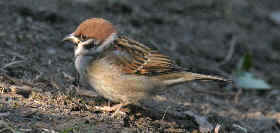
The Eurasian Tree Sparrow is the common "city sparrow"
in Tokyo and other Japanese cities.
House Sparrows don't occur in Japan.
(photo by Paul West)
House Sparrow (JAr) ______
Passer domesticus
The House Sparrow, common as an introduced species in much of
the world, and naturally as a resident in western & central Eurasia,
has occurred as an accidental in Japan on Hokkaido, Honshu, and Hegura
Island, from April to October.
Lesser Masked Weaver (JAi)
______
Ploceus internedius
In Japan, the Lesser Masked Weaver has been introduced and is
now established in central Honshu.
WAXBILLS,
MUNIAS, WHYDAH, & allies
Orange-cheeked Waxbill (JAi)
______
Estrilda melpoda
In Japan, feral populations of the Orange-cheeked Waxbill occur in central
Honshu.
Black-rumped Waxbill (JAi)
______
Estrilda troglodytes
In Japan, the Black-rumped Waxbill is introduced and a local breeder.
Red Avadavat (JAi) ______
Amandava amandava
An introduced population of the Red Avadavat is established in southern
Japan.
Scaly-breasted (or Spotted)
Munia (Amihara) (JAi)
(*) ______ SS,FW
OK:jan,feb,may,nov
Lonchura punctulata
The Scaly-breasted, or Spotted, Munia is also called Nutmeg
Mannikin, or Spice Finch.
White-rumped Munia ______
Lonchura striata
The White-rumped Munia is a resident in Nansei Shoto, perhaps as a natural
colonist.
Black-headed Munia (or Chestnut
Munia) (JAi) ______
Lonchura malacca atricapilla
In Japan, there are established populations of the Black-headed Munia in
Okinawa, Osaka, and Tokyo.
White-headed Munia (JAi)
______
Lonchura maja
In Japan, a feral population of the White-headed Munia is established on
Honshu in the Tokyo area.
Java Sparrow (or Java
Finch)
(t3) (JAi) ______
Lonchura oryzivora
The Java Sparrow occurs as an exotic in southern Japan.
Eastern Paradise Whydah (JAi)
______
Vidua paradisea
In Japan, the Eastern Paradise Whydah is an established exotic in central
Honshu.
ACCENTORS
Japanese Accentor
(Kaya-kuguri = one who goes through dwarf
yew) (JAneb) (*)
______
SS,FW HN:jan,feb,oct
HK:jan,may
Prunella rubida fervida (has been the subspecies on Hokkaido)
Prunella r, rubida (has been the subspecies elsewhere in Japan)
(But now said to be monotypic)
The Japanese Accentor is rare in Hokkaido in the winter.
Alpine Accentor
(Iwa-hibari = rock lark) ______
Prunella collaris
Siberian Accentor (Yama-hibari
= mountain lark)
(JAr) ______
Prunella montanella
PIPITS & WAGTAILS
Richard's Pipit (Mamijiro-tahibari
= white-eyebrowed paddy lark)
(JAr) (*)
______ SS HI:may
Anthus novaeseelandiae
Olive-backed Pipit
(Binzui) (*) (ph)
______ SS,FW HN:jan,feb,apr,may,jun,oct HI:apr,may HK:may,jun
KY:jan,feb,nov,dec AM:jan,dec
Anthus h. hodgsoni (Anthus h. yunnanensis
also occurs)
The Olive-backed Pipit has been called Indian Tree Pipit.

An Olive-backed PIpit, photographed during the
FONT January/February 2009 Tour in Japan
(photo by Karl Frafjord)
Tree Pipit (Yoroppa-binzui)
(JAr) (*) ______ SS HI:may
Anthus trivialis haringtoni (probably this subspecies)
Red-throated Pipit
(Muneaka-tahibari
= red-breasted pipit)
(JAr) (*) ______ FW KY:feb,nov AM:jan
Anthus c. cervinus
"Siberian" Buff-bellied Pipit
(Tahibari
= paddy lark)
(*) ______ SS,FW HN:jan,feb,apr,may HI:may
KY:jan,feb,nov,dec AM:jan,feb OK:jan
Anthus (rubescens) japonicus
The "Siberian Buff-bellied
Pipit", Anthus rubescens japonicus, was part of the Water
Pipit of Eurasia, but now it is considered conspecific with the Buff-bellied,
or American, Pipit of North America, or possibly it is a distinct
species, Anthus japonicus.
Blyth's Pipit (Ko-mamijiro-tahibari)
(JAr) ______
Anthus godlewskii
Pechora Pipit
(Sejiro-tahibari)
(JAr) ______
Anthus gustavi
Forest Wagtail
(Iwani-sekirei = sideways-swinging wagtail) (JAr) (*) ______
FW KY:feb
Dendronanthus indicus (monotypic)
The Forest Wagtail is a rare annual migrant in Japan. Some
breed in the southwest.
Eastern Yellow Wagtail
(Tsumenaga-sekirei = white-eyebrowed
long-clawed wagtail) (JAr)
(*) ______ SS HI:may
Motacilla tschutschensis
Western Yellow Wagtail (JAr)
______
Motacilla flava
Grey Wagtail (Ki-sekirei = yellow wagail)
(*) ______
SS,FW HN:jan,feb,apr,may,jun,nov HI:apr,may
HK:may,jun KY:jan,feb,may,nov,dec AM:jan,feb,nov,dec OK:jan,feb,nov
Motacilla cinerea robusta
White Wagtail
(Hojiro / Haku-sekirei = white
wagtail)
(*) (ph) ______ SS,FW HN:jan,feb,apr,may,jun,jul,oct,nov,dec HI:apr,may
HK:jan,feb,may,jun,nov,dec KY:jan,feb,may,jul,nov,dec
AM:jan,feb,nov,dec OK:jan,feb,nov
Motacilla alba lugens (subspecies throughout Japan; the Black-backed Wagtail) HN HI HK
KY AM OK
Motacilla alba leucopsis (subspecies on Kyushu &
Okinawa; called the "Amur Wagtail") KY OK
Motacilla alba ocularis (subspecies during migration on Hegura
Is., called the East Siberian Wagtail)
HI
Another subspecies from central Asia is a rare visitor
in Japan:
Motacilla alba personata (the "Masked Wagtail")
As noted, three of the above subspecies of the White Wagtail
have been found during FONT Japan Tours.
Japanese Wagtail (Seguro-sekirei
= black-backed wagtail)
(JAe) (*) (ph) ______ SS,FW
HN:jan,feb,apr,may,jun,oct,nov
HK:jan,dec KY:jan,feb,nov,dec OK:jan
Motacilla grandis
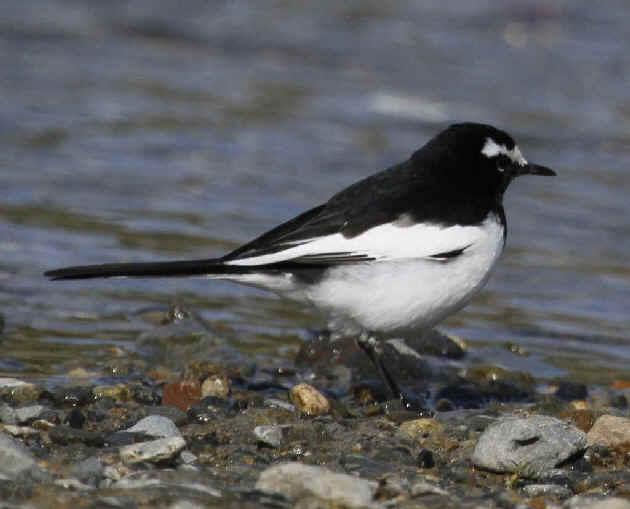
Japanese Wagtail, photographed in
Kyoto in 2015
(photo by James Greenwood)
Citrine Wagtail (Kigashira-sekirei)
(JAr) ______
Motacilla citreola
FINCHES
Brambling (Atori)
(*) (ph) ______ SS,FW HN:jan,oct HI:apr,may
HK:jan KY:jan,nov
Fringilla montifringilla (monotypic)
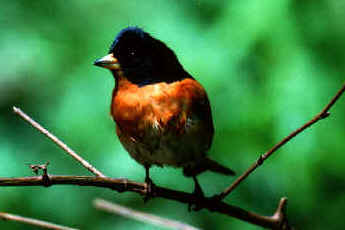
Above & below: Bramblings photographed during FONT tours in Japan
Above: a male. Below: a female
(photos by Paul West)
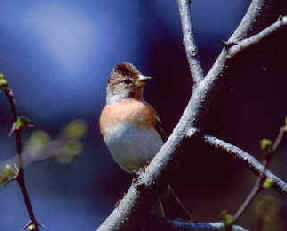
Oriental Greenfinch (Kawara-hiwa = riverside finch) (*) ______ SS,FW HN:jan,feb,apr,may,jun,oct,nov, HIapr,may
HK;jan,feb,may,jun,nov,dec KY:jan,feb,may,nov,dec
Chloris (formerly Carduelis) sinica
(Chloris s. minor breeds
in Japan,
Chloris s. kawarahiba is a winter visitor)
Another name for the Oriental Greenfinch has been Gray-capped
Greenfinch.
Eurasian Siskin
(Ma-hiwa
= true finch)
(*) (ph) ______ SS,FW HN:jan HI:apr,may
HK:jan,feb,jun,nov KY:jan,nov AM:jan,dec OK:jan
Spinus (formerly Carduelis) spinus (monotypic)
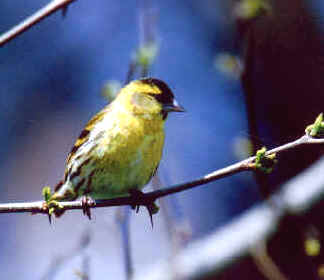
A male Eurasian Siskin
photographed during a FONT Japan Tour
in the Spring
Common Redpoll (Beni-hiwa = rouge finch) (*)
(ph) ______ FW HK:jan,nov
Acanthis (formerly Carduelis) f. flammea
Arctic
(or Hoary) Redpoll (Ko-beni-hiwa
= small rouge finch)
(JAr) ______
Acanthis
(formerly Carduelis) hornemanni exilipes
Pine Grosbeak
(Ginzan-mashiko = silver mountain
rosy-finch)
(*) (ph) ______
SS HK:jun
Pinicola enucleator sakhalinensis
Common (or Red) Crossbill
(Isuka) (*) (ph) ______ FW KY:jan
Loxia curvirostra japonica
Two-barred
(or White-winged)
Crossbill (Naki-isuka = crying crossbill) (JAr) ______
Loxia leucoptera bifasciata
Asian Rosy Finch (Hagi-mashiko = lespedeza
rosy-finch) (*)
(ph) ______ SS,FW HN:jan HI:apr HK:jan,feb,nov
Leucosticte arctoa brunneonucha
The Japanese word
"mashiko"
means
"monkey-child".
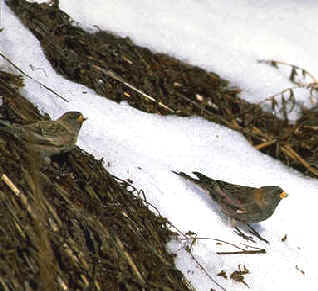
Asian Rosy Finches are seen during FONT Japan Tours
in the Winter
Long-tailed Rosefinch
(Beni-mashiko = red rosy-finch) (*) (ph) ______
SS,FW HN:jan,feb HI:apr
HK:may,nov,dec
KY:jan
Uragus sibiricus sanguinolentus
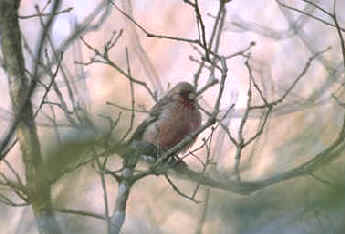
A Long-tailed Rosefinch in Japan in the Winter
Pallas's Rosefinch (JAr)
(O-mashiko = large rosy-finch) (*) (ph) ______
SS,FW
HN:jan,feb,apr
Carpodacus roseus portenkoi
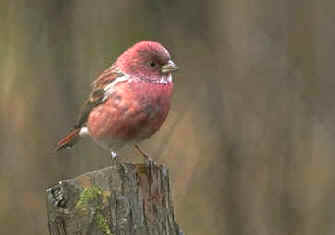
The Pallas's Rosefinch has been seen during FONT Japan Tours
in both the Winter & the Spring, but more so in the Winter
Common
(or Scarlet) Rosefinch
(Aka-masiko)
(JAr) ______
Carpodacus erythrinus
Bonin Grosbeak (Ogasawara-mashiko)
______ (extinct)
Chaunoproctus ferreorostris
The Bonin Grosbeak was endemic to the Ogasawara Islands. It
was discovered in 1827. A search for it in the 1850s was unsuccessful.
Apparently it was uncommon and extirpated by introduced
mammals.
Eurasian Bullfinch
(Uso)
(*) ______ SS,FW HN;jan,feb,may HI:apr,may
HK:jan,feb,may,nov KY:jan,nov
Pyrrhula pyrrhula
Pyrrhula p. rosacea
(subspecies on Hokkaido)
Pyrrhula p. griseiventris (subspecies
on Hokkaido &
Honshu, sometimes known as "Grey-bellied Bullfinch")
Japanese Grosbeak (Ikaru) (*)
______ SS,FW HN:jan,feb,apr,may,jun HI:may
HK:jan,may,jun,nov KY:jan,may,nov
Eophona p. personata
Chinese Grosbeak (JAr)
(Ko-ikaru = small grosbeak) (JAr) (*) (ph)
______ SS
HI:may
Eophona m. migratoria
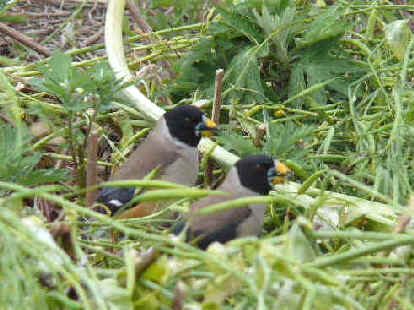
Chinese Grosbeaks during a FONT Japan Tour on
Hegura Island
Hawfinch (Shime)
(*) ______ SS,FW HN:jan,feb,apr,may,nov HI:apr,may
HK:jan,feb,may,jun,dec KY:jan
Caccothraustes caccothraustes japonicus
NEW WORLD WARBLER
Wilson's Warbler (JAr) ______
Wilsonia pusilla
BUNTINGS
Snow Bunting (Yuki-hojiro = snow bunting)
(*) (ph) ______ FW HK:jan
Calcarius (formerly Plectrophenax) nivalis vlasowae
Lapland Bunting
(or Longspur)
(Tsumenaga-hojiro = long-clawed bunting) (*)
______ FW HK:jan
Calcarius lapponicus kamtschaticus
Grey Bunting (JAneb)
(Kuroji =
black small bird)
(*) ______
SS,FW HN:jan,feb,may.jun,nov,dec HI:may
HK:may KY:jan,feb AM:dec OK:feb
Emberiza v. variabilis
Black-faced Bunting (Aoji
= greenish small bird)
(*) ______
SS,FW
HN:jan,feb,apr,may,jun,oct,nov
HI:apr,may HK:may,jun KY:jan,feb,nov,dec
AM:jan,feb,nov,dec
Emberiza spodocephala personata (subspecies
breeds throughout Japan:
"Masked Bunting")
Emberiza s. spodocephala
(subspecies breeds on mainland Asia; winters in
Nansei Shoto & seen in migration on Hegura Island)
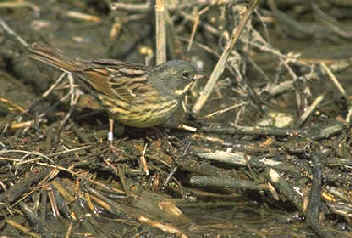
Black-faced Bunting
Japanese Yellow Bunting (Nojiko
= field path child)
(t3) (JAeb) (*) ______
SS HN:may
HI:may
Emberiza sulphurata (monotypic)
The Japanese Yellow Bunting has also been called Siebold's
Bunting..
Meadow Bunting
(Hijiro
= white cheek)
(*) ______
SS,FW HN:jan,feb,apr,may,jun,oct,nov HI:may(once)
HK:jun KY:jan,feb,may,jul,nov,dec
Emberiza cioides ciopsis
Yellow-breasted Bunting
(Shima-aoji = island green bunting) (*) (ph) ______
SS HI:may
HK:jun
Emberiza aureola ornata
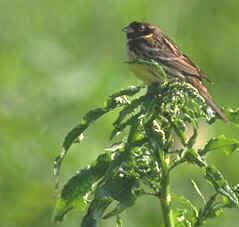
Yellow-breasted Buntings breed on Hokkaido, Japan
in the Spring and Summer
Chestnut Bunting (Shima-nojiko
= island yellow bunting)
(JAr) (*) ______ SS
HI:may
Emberiza rutila (monotypic)
Chestnut-eared (or
Grey-headed)
Bunting (Hoaka = red cheek) (*)
______ SS,FW HI:may KY:jan,feb,dec
Emberiza f. fucata
Rustic Bunting (Kashiradaka = high head) (*)
______ SS,FW HN:jan,feb,apr,may,oct HI:apr,may
HK:jan,dec KY:jan,nov,dec
Emberiza rustica latifascia
Elegant Bunting
(Miyama-hojiro
= mountain-country bunting)
(*) (ph) ______ SS,FW HN:jan HI:apr,may
KY:jan,feb,may,nov,dec AM:feb,dec
Emberiza e. elegans
The Elegant Bunting has been called the Yellow-throated Bunting.
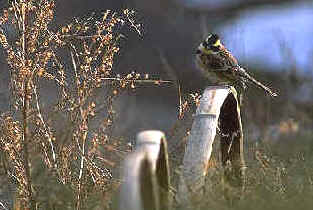
Elegant Buntings breed on mainland Asia, but in the winter
they occur in Japan.
During that season, they've been seen during FONT tours on Honshu, Kyushu,
& Amami.
The species has also been seen during FONT Japan Tours in the Spring.
Yellow-browed Bunting (Kimayu-hojiro) (JAr) (*)
______ SS HI:may
Emberiza chrysophrys (monotypic)
Little Bunting (Ko-hoaka
= lesser red cheek) (JAr) (*)
______
SS HI:may
Emberiza pusilla (monotypic)
Tristram's Bunting (Shirohara-hojiro)
(JAr) (*) (ph) ______ SS
HI:may
Emberiza tristrami (monotypic)
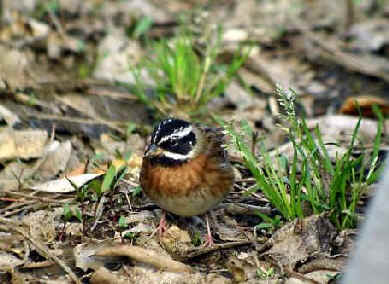
A Tristram's Bunting during a FONT Japan Tour
on Hegura Island
Common Reed Bunting
(O-jurin = large reed bunting) (*) ______
SS,FW HN:jan,feb,apr,may,oct HI:apr,may
HK:dec KY:jan,feb,nov,dec
Emberiza schoeniclus pyrrhulina
Pallas' Reed Bunting (Shiberia-jurin = Siberian reed
bunting) (JAr)
(*) ______ FW KY:jan,feb,nov
Emberiza pallasi minor
Japanese Reed Bunting (Ko-jurin
= small reed bunting)
(nt) (*) (ph) ______
SS,FW HN:jan,apr,may
Emberiza y. yessoensis
The Japanese Reed Bunting has also been
called the Ochre-rumped Bunting.
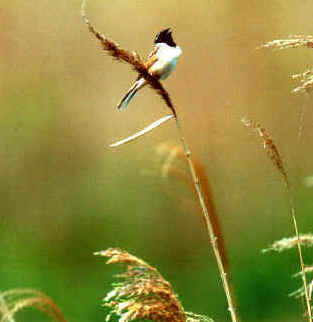
A singing Japanese Reed Bunting photographed
during a FONT Japan Tour in the Spring
(photo by Paul West)
Pine Bunting
(Shiraga-hojiro = white-haired bunting) (JAr) ______
Emberiza leucocephala
Black-headed Bunting
(Zuguro-chakincho = black-headed brownish-yellow bird)
(JAr) ______
Emberiza melanocephala
Ortolan Bunting (Zuao-hojiro)
(JAr) ______
Emberiza hortulana
Grey-necked Bunting (JAr)
______
Emberiza buchanani
The Grey-necked Bunting, of central Asia, has occurred in Japan as an
accidental, in October.
Red-headed Bunting (JAr)
______
Emberiza bruniceps
The Red-headed Bunting, of central Asia, has occurred as a vagrant in
offshore Japan.
Yellowhammer (Ki-aoji
= yellow-green bunting)
(JAr) (ph) ______
Emberiza citrinella
Savannah Sparrow (Sabanna-shitodo)
(JAr) (ph) ______
Ammodramus sandwichensis
Shitodo is an ancient Japanese name for "bunting".
Also used for the White-crowned Sparrow and Golden-crowned
Sparrow,
below.
Fox Sparrow
(Gomafu-suzume = seseme-spotted sparrow) (JAr) ______
Passerella
(formerly Zonotrichia) iliaca
unalaschcensis
Passerella iliaca
unalaschcensis is the Sooty Fox Sparrow that breeds
in southern Alaska.
White-crowned Sparrow (Miyama-shitodo
= mountain country bunting)
(JAr) (ph) ______
Zonotrichia leucophrys gambelii
Golden-crowned Sparrow (Kigashira-shitodo
= yellow-headed bunting)
(JAr) ______
Zonotrichia atricapilla
Song Sparrow (JAr) (ph) ______
Melospiza melodia maxima
Melospiza melodia sanaka
These 2 subspecies of the Song Sparrow, that have occurred in eastern Asia including
Japan, are among almost 40 subspecies in total for the species.
Crested Bunting (JAr) ______
Melophus lathami
The Crested Bunting, an Asian bird normally east to eastern China, has
occurred as an accidental in offshore Japan.
Red-crested Cardinal (JAi)
(ph) ______
Paoaria coronata
In Japan, there is a feral population of the Red-crested Cardinal in
central Honshu.
The bird, of South America, is common in the cagebird trade.
Some Additional Notes:
The Desert Wheatear, a
rarity in Japan, was seen in Tokyo during the January 1998 FONT
tour, present by a small river in the city. It attracted many
Japanese birders (including numerous photographers). Food was put
out for the rather tame bird. Thus, it came in closely to
observers (including us).
The Mugimaki Flycatcher, of
the Asian mainland, is a rare bird in Japan, other than on Hegura and other
offshore islands in the Sea of Japan, where it's a regular migrant, normally in May or October.
In January, the species is
normally found in southern China, Indonesia, and rarely the
Philippines. The breeding range is northern Asia: Manchuria,
southern Siberia, and west to Inner Mongolia. Migration, in the
Spring and the Fall, is normally through eastern and central
China, Korea, and Indochina. The species has been seen in Japan in the Spring
during our tour on Hegira Island in the Sea of Japan.
But more surprisingly, during the FONT 1996 Japan Winter
Birding Tour, on January 28, a pair of Mugimaki Flycatchers were
seen well in southern Kyushu. The male and female, associating
with each other, in a forested area, at a roadside stop, in the
Ebino Plateau. The male was photographed.
The Eurasian Magpie has occurred in Japan
for decades on the island of Kyushu in the area of
Fukuoka. Recently, it has also occurred locally in southwestern Hokkaido.
To Top of Page


 Japan
Birds
Japan
Birds




































